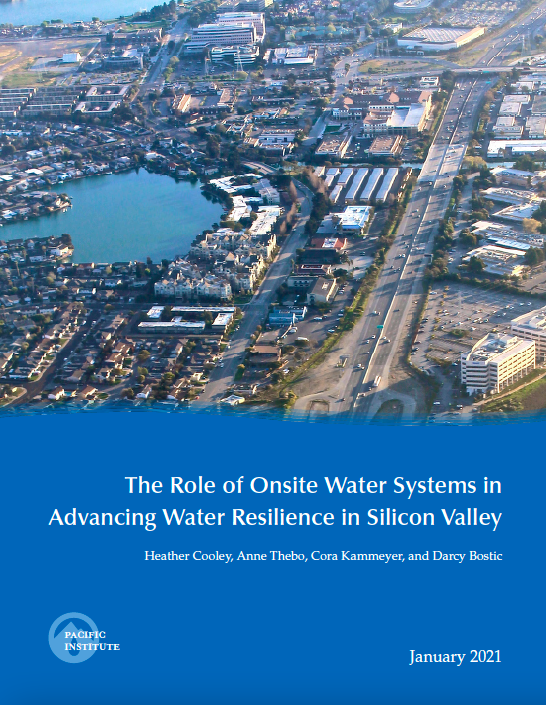The Role of Onsite Water Systems in Advancing Water Resilience in Silicon Valley

The Role of Onsite Water Systems in Advancing Water Resilience in Silicon Valley
Overview
California’s Silicon Valley faces a host of water challenges. The region’s water and wastewater infrastructure are aging, and in some cases are nearing the end of useful life. Continued growth and development are putting additional strains on the region, and climate change is adding to that burden through sea level rise, more intense storms, and more severe droughts. These challenges present risks but also an opportunity to rethink the design, configuration, and operation of water and wastewater systems.
This report examines the opportunity for corporate investments in onsite non-potable water systems in Silicon Valley. These systems capture and treat water sources generated from within or surrounding a building, such as wastewater or stormwater, and then reuse the treated water onsite or locally for non-drinking purposes, such as toilet flushing, clothes washing, and irrigation. The report finds that these distributed systems can work effectively with centralized water systems to foster resilient communities. This is best done by deliberately siting and integrating onsite water systems into the broader water network. The authors provide a set of recommendations to ensure effective siting and integration of onsite water systems.
Key Findings
Key findings from the report include:
- California’s Silicon Valley faces many water-related challenges, from water scarcity to urban flooding, aging infrastructure, and more. These challenges present risks, but also an opportunity to rethink water management approaches.
- There is a growing interest in distributed water solutions to help improve Silicon Valley’s water resilience. For example, leading technology companies in Silicon Valley are investing in onsite non-potable water systems (ONWS) at new office and campus developments. These systems collect, treat, and reuse water from sinks, showers, laundry, toilets, and cooling towers for toilet flushing and outdoor irrigation.
- If implemented widely, ONWS have the potential to fundamentally shift water use and wastewater production patterns in Silicon Valley, altering water, greenhouse gas, and other resource needs. This can provide a wide range of benefits, such as enhancing water supply reliability, improving water quality, reducing localized flooding, increasing urban green space, and advancing innovation. However, it can also create adverse impacts if done poorly and without integration with other water systems.
- Corporate investments in ONWS have the potential to provide multiple benefits to Silicon Valley’s water systems and communities, but only if implemented in coordination with broader regional water planning efforts. This requires meaningful collaboration between the public and private sectors.
- In Silicon Valley, areas slated for new development or redevelopment that are not served by existing recycled water networks could be good candidates for ONWS. This may not lead to a significant reduction in the overall water demands of the region but may reduce the need for expensive and disruptive water infrastructure expansion projects.
- Distributed and centralized systems can complement one another to create more resilient communities if ONWS are deliberately sited and effectively integrated into the broader water network, with explicit acknowledgement and management of the interconnections. In contrast, implementation of ONWS that ignores system constraints and opportunities could lead to undesirable outcomes.

